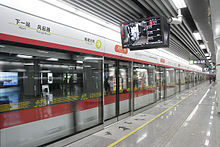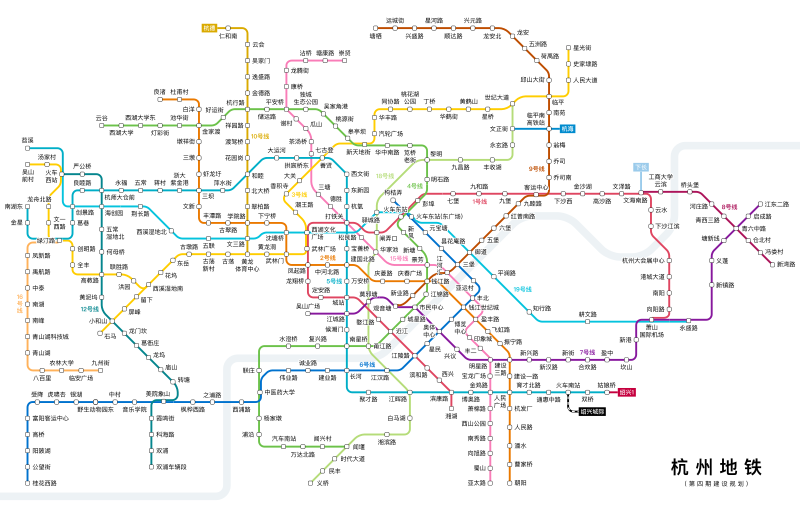Hangzhou Metro
| Hangzhou Metro | |||
|---|---|---|---|
 | |||
 | |||
| Overview | |||
| Owner | City of Hangzhou | ||
| Locale | Hangzhou, Zhejiang, China | ||
| Transit type | Rapid transit | ||
| Number of lines | 13 | ||
| Number of stations | 270 | ||
| Daily ridership | 2,461,300 (2021 avg.) 3,539,000 (4 March 2022, Peak) | ||
| Operation | |||
| Began operation | November 24, 2012 | ||
| Operator(s) | Hangzhou Metro Corporation (Line 2, Line 3, Line 4, Line 6, Line 7, Line 8, Line 9, Line 10, Line 16, Line 19) MTR Corporation (Hangzhou) (Line 1, Line 5) | ||
| Technical | |||
| System length | 516 km (321 mi)[1] (metro lines only, excluding Hanghai line) 562 km (349 mi) (metro + commuter rail, including Hanghai line) | ||
| Track gauge | 1,435 mm (4 ft 8+1⁄2 in) | ||
| |||
| Hangzhou Metro | |||||||||||
|---|---|---|---|---|---|---|---|---|---|---|---|
| Simplified Chinese | 杭州地铁 | ||||||||||
| Traditional Chinese | 杭州地鐵 | ||||||||||
| |||||||||||
The Hangzhou Metro (Chinese: 杭州地铁) is a rapid transit system that serves Hangzhou in Zhejiang province, China. The system opened on November 24, 2012.[2] It is the 17th city in China to operate a rapid transit system.
Network
There are currently 12 lines in operation. The adjacent Shaoxing Metro connects the system at Guniangqiao station on Line 5, and the Hangzhou-Haining Intercity Rail connects to the system at Linpingnan Railway Station on Line 9.
- Line 1 is an arc-shaped line, begins at Xianghu in Xiaoshan, stretches across downtown Hangzhou[3] after crossing the Qiantang River and ends at Hangzhou Xiaoshan Int'l Airport. It connects West Lake, Hangzhou Railway Station, Hangzhou East Railway Station, Xiasha Higher Education Park and the Airport. It used to have a branch line to Linping District, which became part of Line 9 in July 2021.
- Line 2 links the Xiaoshan Industrial Park with Qianjiang Century City, Downtown Hangzhou and Liangzhu in Yuhang District. It runs in northwest–southeast direction.
- Line 3 begins in Xingqiao subdistrict in Linping District, runs in northeast–southwest direction and terminates at Wushanqiancun, North of Hangzhou West Railway Station. A branch commence near Xixi Wetland and connects Xiaoheshan Higher Education Park.
- Line 4 is a "?" shaped line that stretching from Puyan to Chihua Street in north Sandunzhen in Xihu District. It connects Puyan, West Lake scenic area south, Qianjiang New City, Hangzhou East Railway Station and several residential areas in the north part of the city.
- Line 5 is a "Z" shaped line stretching from Future Sci-Tech City in Yuhang District, passing multiple areas in the downtown and ends near Hangzhou-Shaoxing city limit. It provides multiple points of transfer and it is one of the busiest line in the system, serving more than 500,000 passengers per day.
- Line 6 connects Fuyang District with Olympic Sports Park, Qianjiang Century City, Asian Games Village and the Hangzhou East Railway Station. It is one of two metro lines linking the main venue of 2022 Asian Games.
- Line 7 links the West Lake with Qianjiang New City, Olympic Sports Park, Hangzhou Xiaoshan Int'l Airport and Dajiangdong Industrial Park.
- Line 8 provides a link between Xiasha Higher Education Park and Dajiangdong Industrial Park.
- Line 9 provides a link between Qianjiang New City and Linping District. The section between Linping and Coach Center was part of Line 1 until 10 July 2021.
- Line 10 provides a North–South link between Huanglong Sports Center and Renhe subdistrict in Yuhang. It plans to connect Hangzhou-Deqing Intercity Rail in the future.
- Line 16 is an express metro line linking Lin'an District with Yuhang District.
- Line 19 is an express metro line linking Hangzhou West Railway Station, Hangzhou East Railway Station and Hangzhou Xiaoshan International Airport.
The Hangzhou Metro has the only metro system map in China whose first seven lines follow the hue order of the rainbow colors.[4]

Metro
| Line | Terminals (District) |
Commencement | Newest Extension |
Length km |
Stations | Operator | |
|---|---|---|---|---|---|---|---|
| 1 | Xianghu (Xiaoshan) |
Xiaoshan International Airport (Xiaoshan) | 2012 | 2020 | 53.1 | 33 | |
| 2 | Chaoyang (Xiaoshan) |
Liangzhu (Yuhang) |
2014 | 2017 | 43.3[5] | 33 | |
| 3 | Xingqiao (Linping) |
Wushanqiancun (Yuhang) |
2022 | 2022 | 57.5[6] | 37 | |
| 4 | Chihua Street (Xihu) |
Puyan (Binjiang) |
2015 | 2022 | 46.8 | 32 | |
| 5 | Jinxing (Yuhang) |
Guniangqiao (Xiaoshan) |
2019 | 2020 | 53.9 | 38 | |
| 6 | Goujulong (Shangcheng) |
West Guihua Road (Fuyang) Shuangpu (Xihu) |
2020 | 2021 | 58.5 | 34 | |
| 7 | Jiangdong'er Road (Qiantang) |
Wushan Square (Shangcheng) |
2020 | 2022 | 47.5 | 24 | |
| 8 | South Wenhai Road (Qiantang) |
Xinwan Road (Qiantang) |
2021 | – | 17.2 | 9 | |
| 9 | Guanyintang (Shangcheng) |
Long'an (Linping) |
2021 | 2022 | 29.5 | 19 | |
| 10 | Yisheng Road (Yuhang) |
Huanglong Sports Center (Xihu) |
2022 | 2022 | 14.7 | 10 | |
| 16 | Lvting Road (Yuhang) |
Jiuzhou Street (Lin'an) |
2020 | – | 35.1[7] | 12 | |
| 19 | West Railway Station (Yuhang) |
Yongsheng Road (Xiaoshan) |
2022 | – | 59.14 | 17[a] | |
| Total | 516[1] | 258 | |||||
History
Initial plans
The planning for a metro system in the city started in the 1990s and was about to start construction works in September 2003, but the State Council suspended construction works due to increasing costs. The state council approved the construction and operation of a rapid transit system by the Hangzhou Subway Group Co. Ltd in Hangzhou on June 5, 2005.[8] The preliminary design for the first line, Line 1, was approved on January 11, 2007, by the Development and Reform Commission after four days of study. It would be 47.97 km (29.81 mi) long, of which 41.36 km (25.70 mi) is underground, 6.14 km (3.82 mi) elevated, and 0.47 km (0.29 mi) at grade.[9]
Construction


Construction of the first phase of Hangzhou Metro Line 1 began on March 28, 2007, with subsequent phases beginning later in that year. The first phase included three underground stations in Qianjiang New City. Jiubao East Station is the biggest station along Line 1 and will be a hub for the future metro system and other forms of public transport.[3] The funding of Line 1 came from both the city government and the banks, with 10.2 billion yuan and 5 billion yuan respectively. The first phase construction was estimated to be 45 billion yuan.[8]
In January 2009, it was announced that MTR Corporation would invest in a 22 billion-yuan ($3.2 billion) / 25-year / 49% share joint venture with the Hangzhou government to operate Line 1 of the metro.[10]
The first section of Line 4 opened for trial operation on February 2, 2015.[11]
In December 2016, the National Development and Reform Commission approved the planning for 10 lines, including extensions to the three existing lines, scheduled to open in time for the 2022 Asian Games.[12] By then the Hangzhou Metro network is projected to be 446 km (277 mi) long.[13] As of 2018 there are over 300 km (186 mi) of subway lines under construction in Hangzhou.[14]
Accident
On November 15, 2008, a 75-metre (250 ft) section of the tunnel near Fengqing Avenue in Xiaoshan District collapsed while under construction,[15] killing 17 people.[16]
Future expansions

Under Construction
| Years | Lines | Section | Terminals | Length
(km) |
Stations | Notes & References | |
|---|---|---|---|---|---|---|---|
| 2023 | 5 | Phase 2 Adjustment Section | Jinxing | East Nanhu[17] | 2.03 | 1 | |
| 2026 | Hangde | Phase I | Renhe North | Deqing High-speed Railway Station | 25.9 | 9 | [18][19] |
Phase IV Expansion
On November 14, 2022 the NDRC approved the 4th Phase Expansion plan consisting of 152.9km of new lines.[20]
| Years | Line | Length km |
Stations | Notes & References |
|---|---|---|---|---|
| Before 2027 | 3 Phase II | 7.5 | 5 | [20] |
| 4 Phase III West | 5 | 4 | ||
| 4 Phase III South | 5 | 5 | ||
| 9 Phase II | 10.1 | 7 | ||
| 10 Phase II | 5.8 | 3 | ||
| 10 Phase III | 5 | 2 | ||
| 12 Phase I North | 24.3 | 14 | ||
| 12 Phase I South | 1.7 | 1 | ||
| 15 Phase I | 40.5 | 30 | ||
| 18 Phase I | 48 | 19 | ||
| Total | 152.9 | 90 | ||
Notes
- ^ Includes unopened stations Jingchang Road, Wulian & Yicheng Road stations. Excludes unopened Tiaoxi to the west
References
- ^ a b "运营总里程达516公里 9月22日杭州地铁三期线网将全部贯通". September 21, 2022. Archived from the original on September 22, 2022.
- ^ "本网快讯:杭州地铁时代即将来临 1号线24日开通". Archived from the original on June 17, 2013. Retrieved November 22, 2012.
- ^ a b Kat Jiang, "Hangzhou to build metro system Archived September 27, 2007, at the Wayback Machine, Shanghai Daily, 2007-03-01
- ^ "七色彩虹! 杭州地铁每条线颜色是怎么出炉的?看揭秘". Archived from the original on July 1, 2020. Retrieved July 1, 2020.
- ^ "今天17时,地铁2号线全程开通 从头坐到尾只需77分钟". December 27, 2017. Archived from the original on October 16, 2019. Retrieved October 16, 2019.
- ^ "三线齐发!今天11时,杭州地铁3号线首通段、4号线二期、10号线首通段开通". February 21, 2022. Archived from the original on February 21, 2022. Retrieved February 21, 2022.
- ^ "杭州地铁16号线开通在即 余杭到临安不到38分钟". April 9, 2020. Archived from the original on October 30, 2020. Retrieved April 19, 2020.
- ^ a b Tang Fuchun, Hangzhou Subway Planning Approved Archived February 11, 2007, at the Wayback Machine, china.org.cn, 2005-06-16
- ^ "Design of Hangzhou Metro Line No.1 Brings Convenience to Passengers". January 11, 2007. Archived from the original on May 22, 2011.
- ^ "MTR to Operate, Invest in $3.2 Billion Subway in Eastern China". bloomberg.com. January 16, 2009. Retrieved April 30, 2015.
- ^ "experimental operation on Metro Line 4 first section, February 2". hangzhou.gov.cn (in Chinese). February 2, 2015. Archived from the original on February 4, 2015. Retrieved February 4, 2015.
- ^ "杭州地铁三期10条线路获批 计划亚运会前建成". December 21, 2016. Archived from the original on April 18, 2018. Retrieved February 11, 2017.
- ^ "[浙江]杭州地铁2号线西北段开通 22分钟城西飞驰到城东(图)". news.sina.com.cn. July 5, 2017. Archived from the original on October 20, 2017. Retrieved July 6, 2017.
- ^ "穩增長 內地掀新一波城市軌道建設熱 - 香港經濟日報 - 中國頻道 - 經濟". china.hket.com. Archived from the original on August 23, 2018. Retrieved August 26, 2018.
- ^ http://www.shanghaidaily.com/article/?id=380858&type=National [dead link]
- ^ "Deaths from PRC's worst subway accident hit 17". Archived from the original on March 5, 2012. Retrieved November 27, 2008.
- ^ "杭州市人民政府关于杭州机场轨道快线工程、地铁3号线一期工程及5号线二期工程车站站名的批复". June 16, 2022. Archived from the original on June 16, 2022.
- ^ "杭州至德清市域铁路工程环境影响评价第一次公示". huzdq.zjzwfw.gov.cn. Retrieved November 18, 2022.
- ^ "杭州至湖州德清市域鐵路工程開工". zj.people.com.cn. Retrieved November 18, 2022.
- ^ a b "官宣:杭州地铁四期规划(2022-2027年)获批!线路走向图公布-杭州新闻中心-杭州网". hznews.hangzhou.com.cn. Retrieved November 18, 2022.
External links
- Hangzhou Metro (official site) (in Chinese)
- Urbanrail page on the Hangzhou Metro

